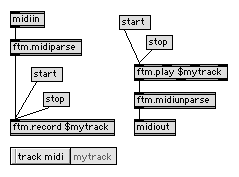| Line 1: | Line 1: | ||
| − | |||
| − | |||
The main purpose of FTM is the representation and processing of sound, music and motion capture data in Max/MSP extending the data types processed and exchanged by the Max/MSP modules. | The main purpose of FTM is the representation and processing of sound, music and motion capture data in Max/MSP extending the data types processed and exchanged by the Max/MSP modules. | ||
Revision as of 18:34, 1 December 2006
The main purpose of FTM is the representation and processing of sound, music and motion capture data in Max/MSP extending the data types processed and exchanged by the Max/MSP modules.
The FTM library and a package of basic externals is based on the jMax project and distributed under the Lesser GNU Public License (LGPL).
The sources of FTM are available via [CVS at SourceForge.net]
Data Structures
FTM allows for static and dynamic creation of complex data structures. The following classes are currently implemented and documented:
| mat | ... | matrix of arbitrary values |
| dict | ... | dictionary of arbitrary key/value pairs |
| track | ... | sequence of time-tagged values |
| fmat | ... | matrix of floats |
| bpf | ... | break point function |
| tuple | ... | immutable array of arbitrary values |
| scoob | ... | score object (note, trill, rest, etc.) |
| midi | ... | midi event |
FTM objects can contain references to other FTM objects. A simple garbage collector handles transparently the destruction of dynamically created FTM objects referenced by multiple elements of a patch.
Static FTM objects are created in a patcher using a dedicated Max/MSP external called ftm.object.
They can be named within a local or global scope and marked persistent to be saved within the patcher. FTM provides a serialization mechanism to recursively save the content of objects and the contained objects.
FTM externals can refer to FTM objects and dynamically create objects. FTM objects can be sent in lists or as single values using a dedicated FTM object message.
While basic operations of FTM objects are implemented as methods of the FTM classes, more complex interactions with FTM objects use operators in form of Max/MSP externals.
Operators
FTM comes with an extended message box - the ftm.mess external - which integrates classical Max message syntax with FTM names, infix expression evaluation, function calls and method invocation including return values.
Apart from ftm.object and ftm.mess, FTM includes a set of externals implementing basic functionalities such as iteration, playing, interpolation, etc. and the conversion between FTM objects and Max values or lists.
Operators specific to a certain field of applications are assembled to separate object sets such as Gabor for sound analysis/resynthesis and MnM for mapping and recognition techniques.
Editors and File Formats
The editors for FTM objects are implemented in Java and integrated into Max/MSP using mxj. Simple double-clicking on an FTM object in a patcher opens its editor.
The communication between FTM objects in a Max/MSP patcher and their Java editors is hidden by the FTM library. By using a transfer protocol such as OSC the GUI could be easily detached from Max/MSP to allow for the distribution of patches and editors among multiple machines.
FTM currently supports simple text files and standard MIDI files. Import and export of SDIF files is currently being finalized and a score interchange format such as MusicXML will be supported in the near future.
Most of these import and export methods are implemented for the FTM track class as it provides a generic container for temporal sequences.
Jitter & JavaScript support
(from FTM 2.0)
From a certain point of view one can look at FTM as something like Jitter. Like Jitter, it is a shared library installed next to the Max/MSP application. Like Jitter, it extends the set of things one can send through the connections and process by Max/MSP externals.
A bridge between FTM and Jitter - the ftm.jitter external - converts FTM matrices into Jitter matrices and vice versa.
FTM objects can also be created, accessed and manipulated in the Max/MSP JavaScript externals js and jsui.



